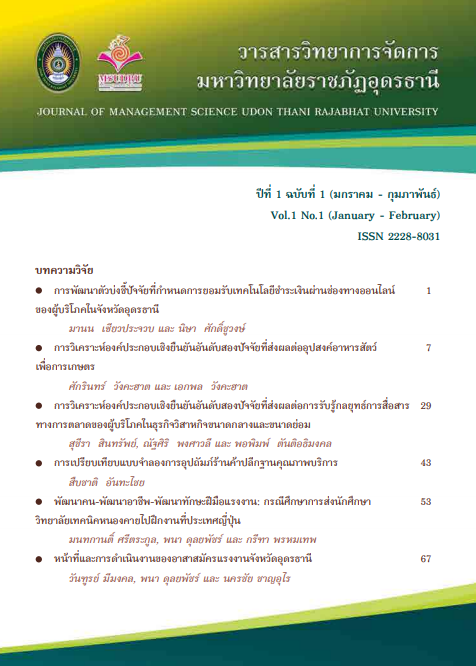การพัฒนาตัวบ่งชี้ปัจจัยที่กำหนดการยอมรับเทคโนโลยีชำระเงินผ่านช่องทางออนไลน์ของผู้บริโภคในจังหวัดอุดรธานี
Main Article Content
บทคัดย่อ
การวิจัยในครั้งนี้มีวัตถุประสงค์เพื่อ 1) พัฒนาตัวบ่งชี้ปัจจัยที่กำหนดการยอมรับเทคโนโลยีชำระเงินผ่านช่องทางออนไลน์ของผู้บริโภคในจังหวัดอุดรธานี 2) ตรวจสอบความตรงเชิงโครงสร้างของแบบจำลองปัจจัยกำหนดการยอมรับเทคโนโลยีชำระเงินผ่านช่องทางออนไลน์ของผู้บริโภคในจังหวัดอุดรธานีด้วยการวิเคราะห์องค์ประกอบเชิงยืนยันอันดับสอง กลุ่มตัวอย่างเป็นผู้บริโภคในจังหวัดอุดรธานีที่ใช้บริการชำระเงินผ่านช่องทางออนไลน์จำนวน 500 คน เครื่องมือที่ใช้ในการวิจัยคือ แบบวัดปัจจัยที่กำหนดการยอมรับเทคโนโลยี ทำการวิเคราะห์ข้อมูลด้วยวิธีวิเคราะห์องค์ประกอบ เชิงสำรวจและวิเคราะห์องค์ประกอบเชิงยืนยันอันดับสอง ผลการวิจัยพบว่า ตัวบ่งชี้ปัจจัยที่กำหนดการยอมรับเทคโนโลยีชำระเงินผ่านช่องทางออนไลน์ของผู้บริโภคในจังหวัดอุดรธานี ประกอบไปด้วย 3 องค์ประกอบ ได้แก่ ด้านการรับรู้ความเสี่ยงในการใช้งาน ด้านการรับรู้ความยากง่ายในการใช้งาน และด้านการรับรู้ประโยชน์ในการใช้งาน กล่าวคือ ด้านการรับรู้ความเสี่ยงในการใช้งานประกอบไปด้วยตัวบ่งชี้ความเสี่ยงของข้อมูลส่วนตัว ความเสี่ยงที่จะถูกฉ้อโกง ความเสี่ยงที่เกิดความผิดพลาดและความเสี่ยงเมื่อเทียบกับชำระเงินด้วยเงินสด ด้านการรับรู้ความยากง่ายการในการใช้งาน ประกอบไปด้วยตัวบ่งชี้ความยากง่ายในการเรียนรู้ ความยากง่ายในการใช้งาน ความซับซ้อนขั้นตอนการใช้งาน และการใช้งานจนชำนาญ ด้านการรับรู้ประโยชน์ในการใช้งานประกอบไปด้วยตัวบ่งชี้ความรวดเร็ว การอำนวยความสะดวก ประหยัดเวลา และมีคุณค่า
Article Details

อนุญาตภายใต้เงื่อนไข Creative Commons Attribution-NonCommercial-NoDerivatives 4.0 International License.
บทความที่ได้รับการตีพิมพ์เป็นลิขสิทธิ์ของคณะวิทยาการจัดการ มหาวิทยาลัยราชภัฏอุดรธานี
ข้อความที่ปรากฏในบทความแต่ละเรื่องในวารสารวิชาการเล่มนี้
ไม่ใช่ความคิดเห็นและความรับผิดชอบของผู้จัดทำ บรรณาธิการ กองบรรณาธิการ และคณะวิทยาการจัดการ มหาวิทยาลัยราชภัฏอุดรธานี ความรับผิดชอบด้านเนื้อหาและการตรวจร่างบทความแต่ละเรื่องเป็นความคิดเห็นของผู้เขียนบทความแต่ละท่าน
เอกสารอ้างอิง
กรมการปกครอง. (2560). สถิติประชากรและบ้าน จำนวนประชากรแยกรายอายุ. สืบค้นเมื่อ 10 ตุลาคม 2561, สืบค้นจาก http://stat.dopa.go.th/stat/statnew/upstat_age_disp.php
พลอย เจริญสม.(2555). การฉ้อโกงทางอินเทอร์เน็ตและการระงับข้อพิพาททางออนไลน์. กรุงเทพฯ: สำนักงานพัฒนาธุรกรรมทางอิเล็กทรอนิกส์ (องค์การมหาชน).
สงครามอีคอมเมิร์ซในประเทศไทย. (2560). สืบค้นเมื่อ 10 ธันวาคม 2561, สืบค้นจาก https://ipricethailand.com/insights/mapofecommerce/
สำนักงานคณะกรรมการพัฒนาการเศรษฐกิจและสังคมแห่งชาติ. (2561). ผลิตภัณฑ์ภาคและจังหวัด แบบปริมาณลูกโซ่ พ.ศ. 2559. กรุงเทพฯ: สำนักงานคณะกรรมการพัฒนาการเศรษฐกิจและสังคมแห่งชาติ.
สำนักงานคลังจังหวัดอุดรธานี. (2560). รายงานผลการตรวจสอบการวิเคราะห์ข้อมูลสถิติผลิตภัณฑ์มวลรวมจังหวัด (GPP) 2560. อุดรธานี: สำนักงานคลังจังหวัดอุดรธานี.
สำนักงานพัฒนาธุรกรรมทางอิเล็กทรอนิกส์. (2560). รายงานผลการสำรวจมูลค่าพาณิชย์อิเล็กทรอนิกส์ในประเทศไทย ปี 2560. กรุงเทพฯ: กระทรวงดิจิทัลเพื่อเศรษฐกิจและสังคม
Aaker, J., Benet-Martínez, V., & Garolera, J. (2001). Consumption Symbols as Carriers of Culture: A study of Japanese and Spanish Brand Personality Constructs. Journal of Personality and Social Psychology, 81(3), 492-508.
Bollen, K. A. (1989). Structural Equations with Latent Variables. New York: John Wiley and Sons.
Chen, L. d. (2008). A model of consumer acceptance of mobile payment. International Journal of Mobile Communications, 6(1), 32-52.
Cho, C. Yoon. (2015). Exploring Factors that affect Usefulness, Ease of Use, Trust and Purchase intention in the online environment. International Journal of Management and Information systems, 19(1), 21-35.
Davis, F. D. (1989). Perceived usefulness, perceived ease of use, and user acceptance of information technology. MIS Quarterly, 13(3), 319-340.
Hair, Jr., J.F., Black, W.C., Babin, B.J. and Anderson, R.E. (2010) Multivariate Data Analysis: A Global Perspective. (7th Ed.). New Jersey: Pearson Education.
Hu, L. & Bentler, P. (1999). Cutoff criteria for fit indices in covariance structure analysis: conventional criteria versus new alternatives. Structural Equation Modeling, 6(January – December), 1-55.
Johnson, T. J., & Kaye, B. K. (2002). We believability: A path model examining how convenience and reliance predict online credibility. Journalism & Mass Communication Quarterly, 79(January – December), 619-642.
Joreskog, K.G. & Sorbom, D. (1989). LISREL-7 user's reference guide. Mooresville, IN: Scientific Software.
Lai, P. C. (2015). Perceived Risk As An Extension To TAM Model: Consumers’ Intention To Use A Single Platform E-Payment. Australian Journal of Basic and Applied Sciences, 9(2), 323-331.
Liu, G.D. and Tai, P.T. (2015). A Study of Factors Affecting the Intention to Use Mobile Payment Services in Vietnam. Economics World, 4(6), 249-273.
Nevitt, J., & Hancock, G. R. (2001). Performance of bootstrapping approaches to model test statistics and parameter standard error estimation in structural equation modeling. Structural Equation Modeling, 8(3), 353-377.
Nunnally, J.C. (1978). Psychometric theory. (2nd Ed.). New York: McGraw-Hill.
Rigopoulos, G. & Askounis, D. (2007). A TAM Framework to Evaluate User’s Perception Toward Online Electronic Payments. Journal of Internet Banking and Commerce, 12(3), 1–5.
Saprikis, V., Markos, A., Zarmpou, T., and Vlachopoulou, M. (2018). Mobile Shopping Consumers’ Behavior: An Exploratory Study and Review. Journal of theoretical and applied electronic commerce research, 13(1), 71-90
Yong, A. G., & Pearce, S. (2013). A beginner’s guide to factor analysis: Focusing on exploratory factor analysis. Tutorials in Quantitative Methods for Psychology, 9(2), 79–94.
Zhou, T. (2010). An empirical examination of user adoption of location-based services. Electronic Commerce Research archive, 13(1), 25-39.


